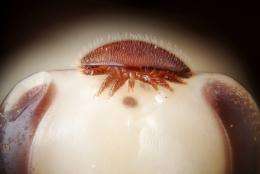Antibiotic dangers trap bees in a Catch 22

Honey bees are trapped in a Catch 22 where antibiotics used to protect them from bacterial illnesses ravaging hives are making them die from commonly used pesticides, some of which are used to ward-off bee-killing parasites.
A study published today into the effect of antibiotics on honey bees adds to the research into the problems plaguing honey bees, including so-called Colony Collapse Disorder (CCD), the abrupt vanishing of bees from hives.
The phenomenon has occurred on a large scale in North America and Western Europe over the past several years, with up to 95 per cent of honey bees disappearing in some areas. Agriculturalists have been alarmed by the disappearance of bees, on whom they depend for the pollination of crops.
In the newly published research from the University of Maryland, the researchers write that “Despite considerable effort, no single cause of the phenomenon called colony collapse disorder (CCD) has been identified, though associations of several pathogens and parasites appear to increase the risk of colony collapse.”
Pathogens such as the voraciously destructive bacterial infection, American foulbrood (which is present in Australia), often require the use of antibiotics or bee populations will be wiped out.
However, aqccording to the University of Maryland Study – “Killing Them with Kindness? In-Hive Medications May Inhibit Xenobiotic Efflux Transporters and Endanger Honey Bees” – antibiotics widely used in the bee industry, such as oxytetracycline, are preventing bees from effectively excreting widely used pesticides.
The antibiotic-induced inability to void common pesticides led to death rates of up to 51 per cent in the study.
Yet, pesticides are commonly used on farms, and if bee handlers do not themselves use pesticides but can find no effective non-chemical protection, then the bees can fall prey to parasites, the most notorious of which is the Varroa destructor mite, a tiny beast which only replicates in bee hives. The varroa destructor is yet to take hold in Australia but it has plagued much of the rest of the world and is very close, with outbreaks in Papua New Guinea, Indonesia, and New Zealand.
But bees seem trapped between enemies, with the authors reporting that “Pesticides are also among the suspected contributing factors of colony collapse both because bees encounter a diverse array of pesticides when foraging and because more than 120 different pesticides have been found within bee hives.”
Andrew Barron, a senior lecturer in biology at Macquarie University, said that among bee-keepers, related scientists and government agencies, “there’s no one who hasn’t worried about the effects of in-hive chemicals – bee-keepers are hugely concerned about it, and in Australia we try to minimise them.”
“There are chemicals that have been cleared for use on bees that are used quite routinely by beekeepers, and what this study is showing is that those chemicals make bees more susceptible to pesticides in the environment,” Dr Barron said.
“Hopefully it will make bee-keepers more wary about applying these drugs but it’s also a Catch 22 because if they don’t treat with the miticides [pesticides used for mites] they’ll lose the colony to the varroa mite and if they don’t treat with oxytetracycline they’ll lose the hive to foulbrood, which is really disgusting; so it’s a question of, ‘Oh, what do we do?’, Dr. Barron said.
It was imperative that researchers and bee-keepers developed a way to control bacterial infections and mite infestations that does not involve introducing chemicals to bee colonies, Dr. Barron said.
But the problem, and solution, could be found not just in the hive but in farming methods beyond.
“Ultimately what we’d like to see is reduced pesticide use in the agricultural landscape, because if we had less pesticide use in the environment we wouldn’t have such a problem,” Dr. Barron said.
This story is published courtesy of the (under Creative Commons-Attribution/No derivatives).
Source: The Conversation

















